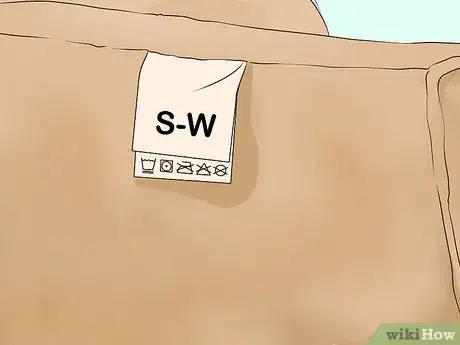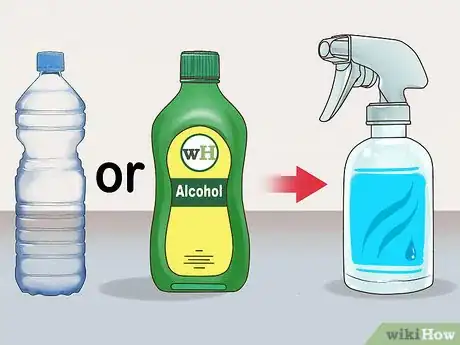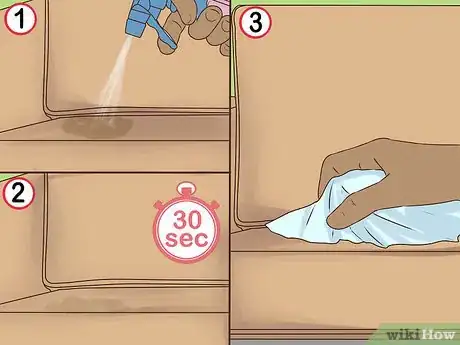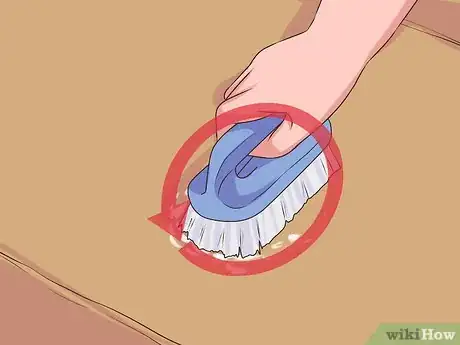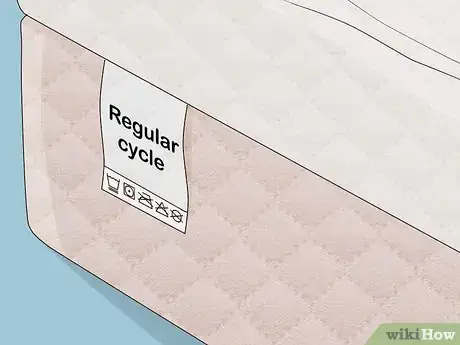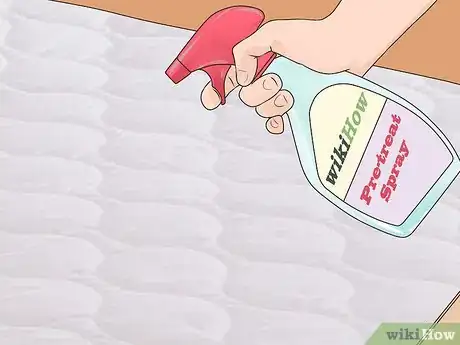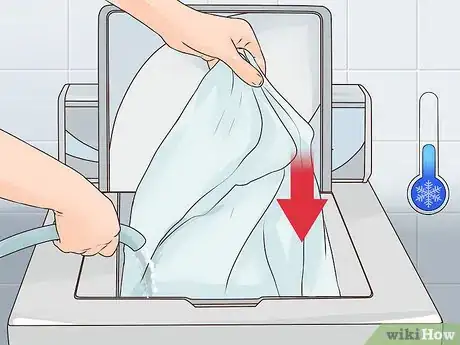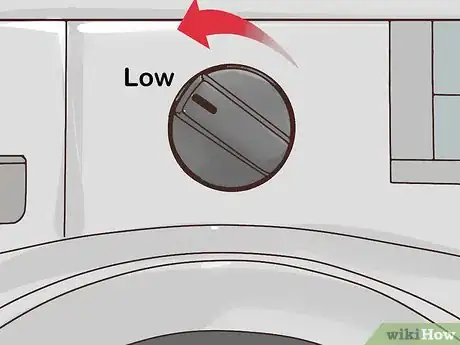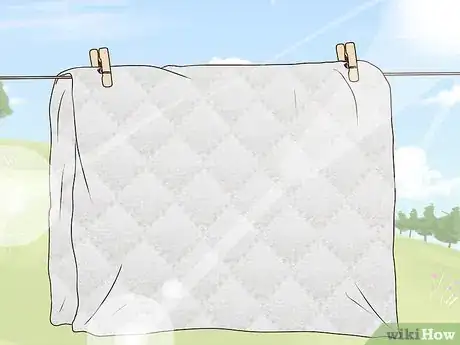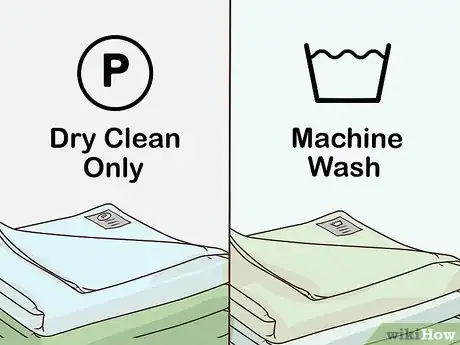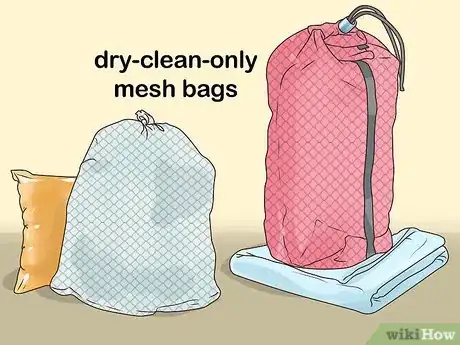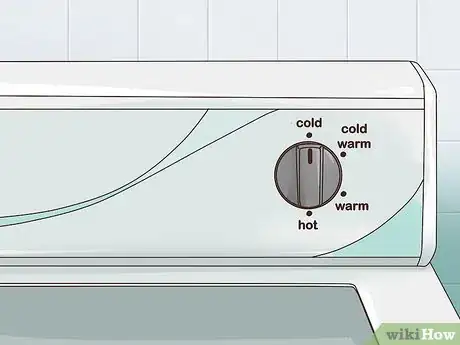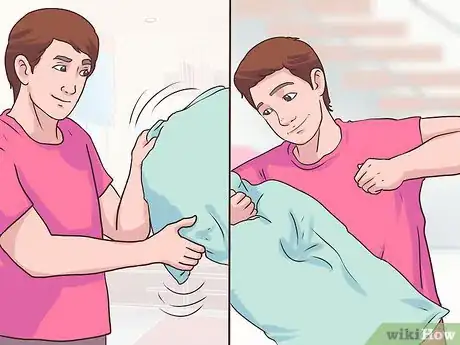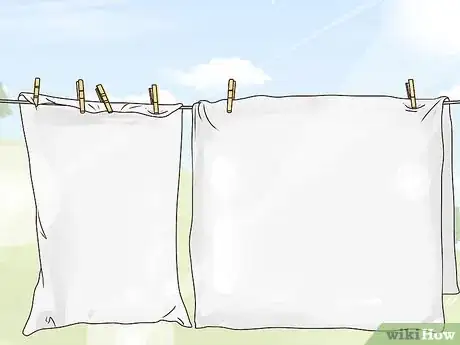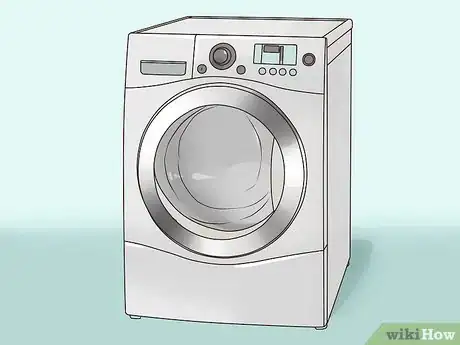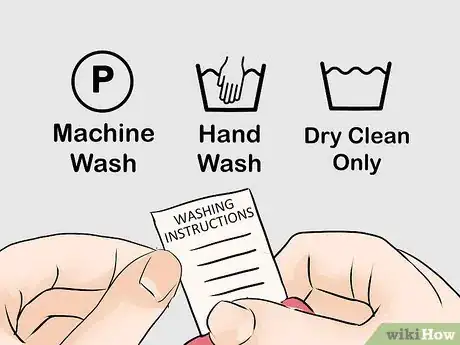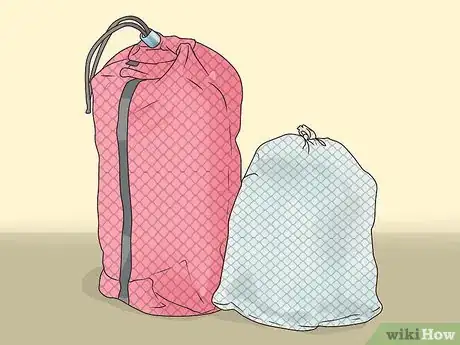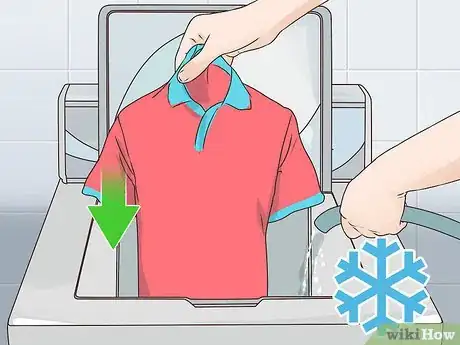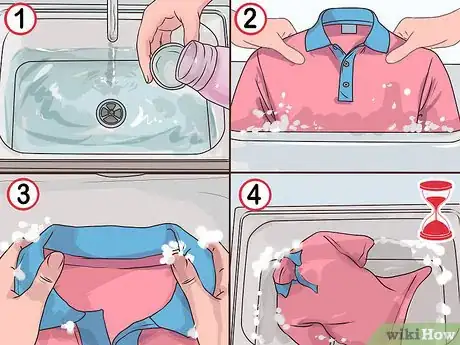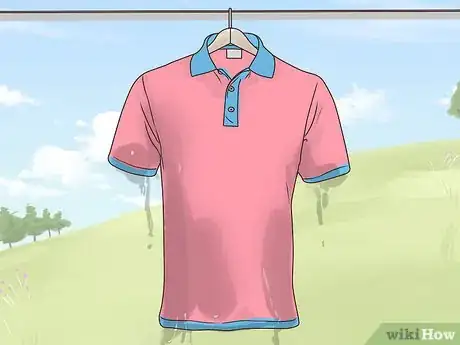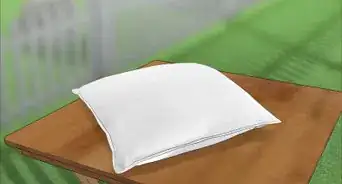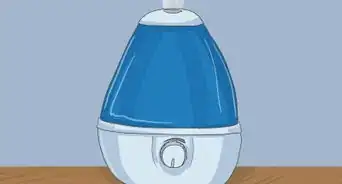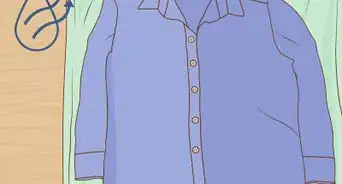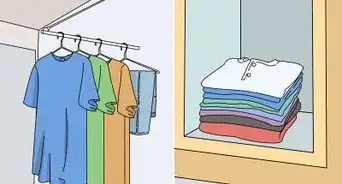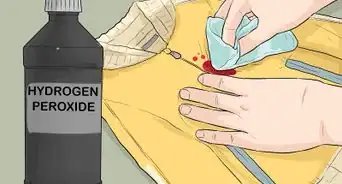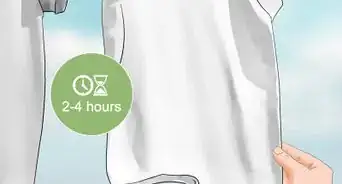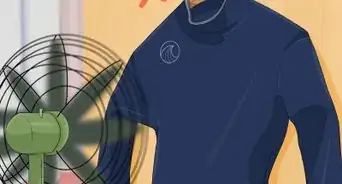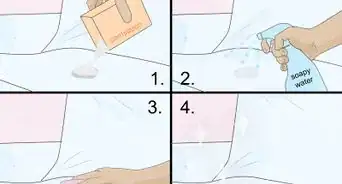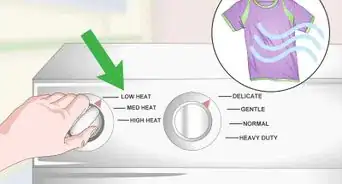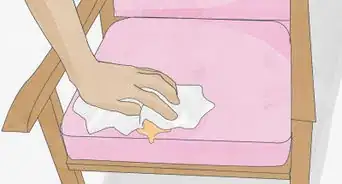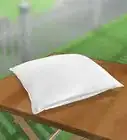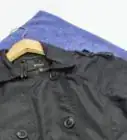This article was co-authored by Alicia Sokolowski. Alicia Sokolowski is a Green Cleaning Specialist and the President and co-CEO of AspenClean, a green cleaning company in Vancouver, British Columbia. With over 17 years of experience, Alicia specializes in creating a healthier, green alternative to chemical-based cleaning products and services. AspenClean develops and manufactures its own line of 100% Natural, EcoCert® certified, and EWG verified™ cleaning products. AspenClean’s glass cleaner was voted Parent’s Green Pick 2020 by readers of the Parents’ magazine. Alicia holds a CPA designation and a Bachelor’s degree in Commerce and Finance from the University of Toronto.
This article has been viewed 32,957 times.
Polyester fiber is synthetic fabric that can mimic the appearance of more expensive materials, such as suede or silk. It's usually easy to clean, but it's important to remember that one cleaning method doesn't fit all polyester objects. Different fabrics require different cleaning methods. In most cases, your situation will involve polyester furniture upholstery, mattress pads, pillows or blankets, or clothing.
Steps
Cleaning Polyester Upholstery
-
1Read the washing instructions on the tag. Most tags on furniture contain codes in the washing instructions. “W” means you should only use water-based solutions. “S” means the fiber can only tolerate solvent-based solutions. “S-W” allows you to use either solvent- or water-based solutions. If you see an “X,” however, you should only vacuum the material.[1]
-
2Fill a spray bottle with water or alcohol. If your tag is coded with “S” or “S-W,” you can fill it with rubbing alcohol or vodka. Otherwise, you should only use water. Avoid using soap, which can leave a stain on the fabric.[2]
- If your tag is coded with an “X,” you should skip this step.
Advertisement -
3Remove the stain(s). Spray the stained area and allow the water or alcohol to sit for about 30 seconds. Then, blot and gently rub the stain with a clean cloth. Move the cloth with the grain of the fabric. The cloth may be made of any absorbent material.[3]
- If your upholstery is vacuum-clean only, attach the brush to the extension hose of your vacuum cleaner. Gently glide the brush across the fabric until the stain has been removed.[4]
-
4Fluff the fabric. This step is necessary only if the fabric feels stiff as it begins to dry. Use a scrub brush with soft bristles or the scrub side of an unused dish sponge. Move the brush or sponge in gentle circles until the fabric feels soft.[5]
Cleaning a Polyester Mattress Pad
-
1Read the washing instructions. Follow the instructions closely to avoid damaging your mattress pad. Pay attention to the recommended cycle (regular or gentle) and which fabrics you can wash the pad with. For example, if your mattress pad is white and the tag specifies “like colors,” avoid throwing dark or dyed materials into the washing machine with it.[6]
-
2Pre-treat stains. Spray the product directly on any stains you find. Commercial pre-treaters are usually safe to use. You should only avoid them if the tag warns against them.[7]
-
3Wash the pad in cold water. Always default to cold water, even if the tag doesn't specify a temperature or allows hot water. Cold water will prevent shrinkage and decrease wear over time. Any kind of laundry detergent is acceptable. Avoid using bleach, which can damage the material.[8]
-
4Tumble dry on a low setting. Low heat will prevent shrinkage of the material or stretching of the elastic. Add two dryer balls (available in most big box stores) if the pad is larger than twin size. If you don't have dryer balls, use two tennis balls. This will prevent the pad from twisting into a ball shape and allow it to dry more thoroughly.
-
5Air dry the pad as an alternative to the dryer. Hang it on a clothesline or lay it on a clean flat outdoor surface. Place it in direct sunlight for the quickest drying time. If the weather isn't cooperating, air dry the mattress on a drying rack or clothes hanger in the warmest location in your home. Make sure both sides are dry before putting it back on your bed.[9]
Cleaning Polyester Pillows and Blankets
-
1Read the washing instructions. Look for the phrases “Dry Clean Only” or “Machine Wash.” Most tags specify cold water and a delicate cycle for machine washable fabrics. Take dry-clean-only fabrics to the dry cleaner for best results.[10]
-
2Purchase mesh bags for “dry-clean-only” materials. Use this step if you can't afford or don't have the time for the dry cleaner. Laundry bags protect delicate fabrics from the agitation of the wash cycle. You can buy them in most big box stores. Use separate bags for the pillow and the blanket. Seal each bag before placing it in the washing machine.[11]
-
3Use the cold water setting. Place the materials in the washing machine. Set the machine to the delicate cycle. Avoid using detergent unless the washing instructions call for it. Add about a capful of fabric softener to the wash.[12]
-
4Shake and punch the pillow. Because pillows contain fabric fill, it's important to take extra steps to remove excess water after the spin cycle completes. Otherwise, you'll risk mold growth. Shaking and punching will also loosen any areas of fill that clumped together during the wash cycle. Do this until you don't feel any clumps inside the pillow.[13]
-
5Air dry in a warm spot. On a hot, sunny day, hang the pillow and blanket on a clothesline in direct sunlight. If it's raining or cold outside, dry the materials near a heating source, such as a heating vent. Avoid laying them directly on objects like space heaters or radiators, as this is a fire hazard.
-
6Use the dryer as an alternative. Take precautions if you choose this step. Place the pillow and blanket in separate drying bags, which you can find in most big box stores. If you don't have drying bags, wrap each item in a separate towel. Set the dryer for the most delicate setting that doesn't use heat. Check the pillow and blanket every 30 minutes. Remove them when they're completely dry.[14]
Cleaning Polyester Clothing
-
1Read the washing instructions. If you see the words “Machine Wash” on the tag, you can toss the garment into the washing machine unprotected. Pay attention to the temperature of the water and the type of cycle you should use. Most tags specify the gentle or delicate cycle. Others state “Hand Wash” or “Dry Clean Only.” For best results, stick to these instructions.[15]
-
2Use a protective bag for “dry-clean” clothing. If you don't have the time or money for the dry cleaner, you can use a sealable mesh laundry bag in the washing machine. If you don't have a mesh bag, use a pillow case. Turn the garment inside out before you put it in the bag. When using a pillow case, seal it with a clothespin or hair tie. Limit one piece of clothing per bag to allow the water and detergent to circulate properly.[16]
- If you plan to hand wash your garment, you can skip this step.
-
3Machine wash most fabrics in cold water. Thicker fabrics can withstand this method. Set the machine to the delicate or gentle cycle. Allow the machine to continue to the rinse and spin cycles.[17]
-
4Hand wash very delicate fabrics, such as knits. For this step, fill a sink with cold water and gentle detergent, such as Woolite. Then, completely submerge the clothing in the soapy water. Take the opposite sides of the garment in each hand and gently rub them together to loosen any debris. Allow the garment to soak for a few minutes.
- Drain the soapy water and refill the sink with clean water. Move the garment up and down in the clean water until the detergent has been completely rinsed out. Roll the garment in a towel to gently push out the excess water. Avoid wringing, which can damage the fabric.[18]
-
5Air dry the garment. Even if you don't have to worry about shrinking, the heat of the dryer can damage the fabric. Weather permitting, hang the clothing on an outdoor clothesline and allow it to dry in the sun. On a hot summer day, your garment could be dry in as little as three hours.
- If it's raining or too cold to hang your garment outdoors, air dry it on a drying rack or clothes hanger. Depending on the temperature and humidity level of your home, your garment will be dry in 24 to 36 hours.[19]
Expert Q&A
-
QuestionWhat kind of cleaner can I use for a polyester couch?
 Alicia SokolowskiAlicia Sokolowski is a Green Cleaning Specialist and the President and co-CEO of AspenClean, a green cleaning company in Vancouver, British Columbia. With over 17 years of experience, Alicia specializes in creating a healthier, green alternative to chemical-based cleaning products and services. AspenClean develops and manufactures its own line of 100% Natural, EcoCert® certified, and EWG verified™ cleaning products. AspenClean’s glass cleaner was voted Parent’s Green Pick 2020 by readers of the Parents’ magazine. Alicia holds a CPA designation and a Bachelor’s degree in Commerce and Finance from the University of Toronto.
Alicia SokolowskiAlicia Sokolowski is a Green Cleaning Specialist and the President and co-CEO of AspenClean, a green cleaning company in Vancouver, British Columbia. With over 17 years of experience, Alicia specializes in creating a healthier, green alternative to chemical-based cleaning products and services. AspenClean develops and manufactures its own line of 100% Natural, EcoCert® certified, and EWG verified™ cleaning products. AspenClean’s glass cleaner was voted Parent’s Green Pick 2020 by readers of the Parents’ magazine. Alicia holds a CPA designation and a Bachelor’s degree in Commerce and Finance from the University of Toronto.
Green Cleaning Specialist There are a bunch of options, but any all-purpose cleaner should work. A basic kitchen cleaner should do the trick, too. Whatever you choose to use, aim to use a natural cleaner.
There are a bunch of options, but any all-purpose cleaner should work. A basic kitchen cleaner should do the trick, too. Whatever you choose to use, aim to use a natural cleaner. -
QuestionWhat do I need to clean my polyester furniture?
 Alicia SokolowskiAlicia Sokolowski is a Green Cleaning Specialist and the President and co-CEO of AspenClean, a green cleaning company in Vancouver, British Columbia. With over 17 years of experience, Alicia specializes in creating a healthier, green alternative to chemical-based cleaning products and services. AspenClean develops and manufactures its own line of 100% Natural, EcoCert® certified, and EWG verified™ cleaning products. AspenClean’s glass cleaner was voted Parent’s Green Pick 2020 by readers of the Parents’ magazine. Alicia holds a CPA designation and a Bachelor’s degree in Commerce and Finance from the University of Toronto.
Alicia SokolowskiAlicia Sokolowski is a Green Cleaning Specialist and the President and co-CEO of AspenClean, a green cleaning company in Vancouver, British Columbia. With over 17 years of experience, Alicia specializes in creating a healthier, green alternative to chemical-based cleaning products and services. AspenClean develops and manufactures its own line of 100% Natural, EcoCert® certified, and EWG verified™ cleaning products. AspenClean’s glass cleaner was voted Parent’s Green Pick 2020 by readers of the Parents’ magazine. Alicia holds a CPA designation and a Bachelor’s degree in Commerce and Finance from the University of Toronto.
Green Cleaning Specialist You'll need a spray bottle cleaner, vacuum, scrub brush, sponge, and a microfiber cloth. That should get the job done in most situations.
You'll need a spray bottle cleaner, vacuum, scrub brush, sponge, and a microfiber cloth. That should get the job done in most situations. -
QuestionWhy does the stain spread when I try to wipe it up?
 Alicia SokolowskiAlicia Sokolowski is a Green Cleaning Specialist and the President and co-CEO of AspenClean, a green cleaning company in Vancouver, British Columbia. With over 17 years of experience, Alicia specializes in creating a healthier, green alternative to chemical-based cleaning products and services. AspenClean develops and manufactures its own line of 100% Natural, EcoCert® certified, and EWG verified™ cleaning products. AspenClean’s glass cleaner was voted Parent’s Green Pick 2020 by readers of the Parents’ magazine. Alicia holds a CPA designation and a Bachelor’s degree in Commerce and Finance from the University of Toronto.
Alicia SokolowskiAlicia Sokolowski is a Green Cleaning Specialist and the President and co-CEO of AspenClean, a green cleaning company in Vancouver, British Columbia. With over 17 years of experience, Alicia specializes in creating a healthier, green alternative to chemical-based cleaning products and services. AspenClean develops and manufactures its own line of 100% Natural, EcoCert® certified, and EWG verified™ cleaning products. AspenClean’s glass cleaner was voted Parent’s Green Pick 2020 by readers of the Parents’ magazine. Alicia holds a CPA designation and a Bachelor’s degree in Commerce and Finance from the University of Toronto.
Green Cleaning Specialist You shouldn't really rub something if you're trying to clean up a stain. You want more of a blotting motion; just gently dab the stain repeatedly. If you rub it, you end up spreading the stain out.
You shouldn't really rub something if you're trying to clean up a stain. You want more of a blotting motion; just gently dab the stain repeatedly. If you rub it, you end up spreading the stain out.
Things You'll Need
- Spray bottle
- Water or alcohol
- Clean cloth
- Soft scrub brush or clean scrub sponge
- Vacuum cleaner with hose and brush attachments
- Pre-treater
- Fabric softener
- Mesh laundry bag or pillow case
- Laundry detergent for delicate fabrics
- Large clean towel
- Drying rack, clothesline, or clothes hanger
References
- ↑ http://www.onegoodthingbyjillee.com/clean-your-microfiber-couch-safe-easy-way
- ↑ http://www.onegoodthingbyjillee.com/clean-your-microfiber-couch-safe-easy-way
- ↑ http://www.onegoodthingbyjillee.com/clean-your-microfiber-couch-safe-easy-way
- ↑ Alicia Sokolowski. Green Cleaning Specialist. Expert Interview. 15 September 2020.
- ↑ Alicia Sokolowski. Green Cleaning Specialist. Expert Interview. 15 September 2020.
- ↑ https://www.hunker.com/12163782/how-to-clean-a-polyester-fiber-mattress-pad
- ↑ https://www.hunker.com/12163782/how-to-clean-a-polyester-fiber-mattress-pad
- ↑ https://www.hunker.com/12163782/how-to-clean-a-polyester-fiber-mattress-pad
- ↑ https://www.hunker.com/12163782/how-to-clean-a-polyester-fiber-mattress-pad
- ↑ https://www.dumblittleman.com/how-do-i-wash-my-100-polyester-fiber-pillow-and-blanket/
- ↑ https://www.dumblittleman.com/how-do-i-wash-my-100-polyester-fiber-pillow-and-blanket/
- ↑ https://www.dumblittleman.com/how-do-i-wash-my-100-polyester-fiber-pillow-and-blanket/
- ↑ https://www.dumblittleman.com/how-do-i-wash-my-100-polyester-fiber-pillow-and-blanket/
- ↑ https://www.dumblittleman.com/how-do-i-wash-my-100-polyester-fiber-pillow-and-blanket/
- ↑ https://www.realsimple.com/home-organizing/cleaning/laundry/do-i-have-to-dry-clean-this
- ↑ https://www.realsimple.com/home-organizing/cleaning/laundry/do-i-have-to-dry-clean-this
- ↑ https://www.realsimple.com/home-organizing/cleaning/laundry/do-i-have-to-dry-clean-this
- ↑ http://www.bhg.com/homekeeping/laundry-linens/clothes/how-to-wash-clothes-by-hand/
- ↑ https://www.realsimple.com/home-organizing/cleaning/laundry/do-i-have-to-dry-clean-this
About This Article
To clean polyester fiber upholstery, start by checking the washing instructions tag. If it's labeled with a "W," only use water to clean it. If it's labeled "S" or "S-W," use a solvent like rubbing alcohol or vodka. If the tag has an "X" on it, only vacuum the upholstery. To use water or a solvent to clean polyester fiber, put it in a spray bottle and spray the spots you want to clean. Let it sit for 30 seconds and then gently rub it into the upholstery with a clean cloth. If the polyester fiber feels stiff after it dries, rub it with a scrub brush or sponge to soften the fabric. If you want to learn how to clean polyester clothing or blankets, keep reading!
